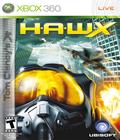Ubisoft Romania is probably best known for its WWII arcade flight sim, Blazing Angels, where pilots would heroically fly against the forces of the Third Reich in an attempt to stem the tide of fascism around the globe. It has also had a rocky history. From the offensively stereotypical chatter portraying certain enemies in the first game to the continuing graphics tearing carried into the second, finding something to enjoy in the series has, to some degree, depended on a player's patience. Now that Ubisoft has begun to stretch Tom Clancy's name in new directions, Ubisoft Romania has found its flight expertise focused on Tom Clancy's H.A.W.X., a techno-thriller aiming squarely at the top gun slot, which is currently held on the 360 by Ace Combat.
Tom Clancy sold the use of his name to Ubisoft for branding purposes for as long as they want it, so they can create Tom Clancy's RC Racer as long as it has something Tom Clancy-ish about it, such as using said racers to disarm a nuclear warhead. In H.A.W.X.'s case, the game takes place in 2012 as David Crenshaw fights in an elite Air Force squadron. Shortly afterward, the squadron is disbanded and its members are enticed into joining private military company, Artemis Global Security, whose private sector paychecks are plenty of incentive. Nine years later, Artemis signs on with Brazil to provide security, which results in consequences that will test the loyalties of Crenshaw and his team.
In H.A.W.X., the cut scenes between each mission feel as if you're viewing them from a high-tech briefing room with flashy elements and great voice acting, but it ultimately feels pretty thin. You feel little camaraderie with your wingmen, who have as much personality as cardboard. Most of the time, the story just provides a reason to rain fire from the skies, which the gameplay does somewhat well.
The game doesn't necessarily copy AC6 — both are arcade flight sims, after all — but fans may notice a few things that will undoubtedly feel familiar. Instead of credits, players can earn "experience" in completing missions and can grind them for more, up to 40 levels' worth. In AC6, this would only unlock additional planes, but H.A.W.X. adds in bonus weapon loadouts for each plane, along with a rank attached to your in-game profile.
Flying with the control pad is made easy, thanks to a simplified control scheme, and players who have the Ace Combat 6 flightstick will be able to use that instead. Tutorials lead potential pilots through the basics, and they can select between a default arcade control setup that simplifies the flight mechanics or the "expert" mode for flight-sim vets who are used to banking and turning their planes in the more traditional sense. There are also several camera views that can be toggled between, such as in-cockpit (with or without instrumentation), or a third-person chase camera from behind.
H.A.W.X. is also equipped with two new tools to help newcomers. One is the Assistance feature, which enables or disables the safeties that prevent the plane from performing some of the crazier stunts. This also changes the available camera options, and not always in the best way. Assistance ON is the default mode that the plane flies in, which is somewhat ironic, but the term "assistance" applies more to these safety features that are built into the system. Assistance OFF switches the view to a third-person perspective from a parallel angle outside of the plane, highlighting most of the enemies around you, as if your helmet had eyes.
With Assistance OFF, the player is able to turn-slide his plane in mid-air by braking and turning in the opposite direction like a flying roadster, a move that should turn the pilot into a pancake but instead allows him to quickly angle the plane. This can help in outmaneuvering circling planes that are chasing your tail or reduce the time needed to get the correct angle on enemy fly-bys. As useful as this sounds, it feels very awkward for traditional sim pilots.
Although it gave me a wide-open view of the airspace around the plane, my inability to change or adjust the camera quickly soured me on the feature. I don't want to waste time second-guessing my own controls against the angle of the plane shown on the screen during a dogfight, so I avoided using this feature for most of the game, aside from the tutorial, which forces you to use it during training.
The other marginally useful tool was the virtual flight path provided by the Enhanced Reality System, or ERS, which creates electronic breadcrumbs on the player's HUD to guide him to the best angle on a particular target. It also takes away some control from the player, which I fought against because I thought it should just provide a path and nothing more. I can see how this can be useful for beginners, but it may get in veterans' way. One mission in the game, however, uses it as a creative tool to help the player penetrate a sophisticated air defense system, which was an exciting use for a feature that I normally would've ignored.
Sharp ground textures and effects courtesy of GeoEye's space imaging add plenty of realism to the visuals, as long as the player doesn't fly too close to notice some of the blurring. The planes come close to those from Namco's AC6 but are not quite as polished, despite the great smoke and explosion effects with each of the weapons. Sound-wise, the music fits each theater, with functional pieces that provide something to listen to while dogfighting, but the weapons sound hard-hitting, as does most of the acting behind the often forgettable dialogue.
The missions keep things simple by asking you to destroy objectives and provide protection to the usual targets or VIPs during the always-irritating escort jobs. Tying the game into the rest of the Tom Clancy universe, protecting Ghost Recon units is only the first of many colorful objectives would-be PMC pilots will encounter. Players can also look forward to stopping an enemy invasion on land, sea and air, and plowing the road for allied forces to attack enemy bases. There's also the occasional bonus mission objective that can add to the experience total that the player will earn at the end of every successful sortie, along with plenty of in-game achievements, which reward even more points.
The enemy AI tends to be a simple beast that abuses one tactic over and over again by circle-jerking your plane and flying around it in the hopes of catching your tail. This can make it easy to lure an enemy behind you and have your wingmen take it out by ordering them to cover you, but not every foe will be as easy to dispatch, especially when they start flying more advanced hardware like Su-47s or F-22s. The enemy can also be drawn into a fight if you happen to fly into their zone of contact, which, while wildly unrealistic, proves to be very useful for drawing enemy fire away from a target you're protecting. The downside is that this tends to bring down the wrath of their entire squadron on you in later missions, with a dozen or so planes gunning for you at the same time. No sweat, right?
Not only can wingmen cover your back, but you can also send them off to attack specific targets, making them quite useful in a massive brawl. They'll follow your orders to the last, and their ability to soak up plenty of damage makes them easier to ignore while you focus on surviving. Unlike Blazing Angels, there's no in-game repair that you can apply to your plane, but some missions are broken up into smaller phases, and your store of a 100+ missiles and gobs of cluster bombs is often miraculously replenished before the next mission starts up.
I can see why Ubisoft Romania had added many newbie-friendly features to the game, since not everyone will have earned their wings on as many sims as Ace Combat, Crimson Skies, or even Tie Fighter or Falcon fans have on other platforms. Make no mistake: This is purely arcade entertainment, and it asks that you leave your sense of reality at the door, aside from appreciating the accuracy of the plane modeling. There are also no real enemy aces in the game other than certain squadrons that are announced in combat chatter, giving them little in the way of recognition or personality other than as targets in your scope.
The short length of the main campaign on the normal difficulty setting means that H.A.W.X. can be finished in as little as six or seven hours. Pilots looking forward to unlocking more of the planes on the extensive list might be somewhat disappointed to see how uneven the selections can be, as they don't scale well in terms of firepower. Some powerful jets are unlocked by simply playing through the main campaign, while others are unlocked through accruing more experience, although they may be less powerful than those that the player already has at his disposal.
Multiplayer offers basic deathmatching with little of the variety offered by other games of this type, such as, again, Ace Combat, although players can play co-op on campaign missions and destroy objectives for additional experience. The deathmatching portion of multiplayer offers little else other than matching up to eight players so they can duke it out over one of several stages for kills. Power-ups that can be used by either side, such as shutting down missiles or disrupting the opponent's radar, add some variety but not enough to make it very interesting, since most fights degenerate into firing multi-missiles.
Even with its issues, I had fun with Tom Clancy's H.A.W.X., but it has a long way to go before it can challenge its peers. It's not a terrible game by any means, and arcade-oriented fighter jocks, especially newcomers looking to earn their wings for the first time, might find something to like within its airspace. Strip away the features that most able pilots will likely ignore, though, and its light-on-realism approach to action offers little else. H.A.W.X. is a nice, action-packed distraction with some promise, but if you're squeezed on cash and are still waiting on the next Crimson Skies or Ace Combat, you might want to sign on as a pilot-for-rent instead.
Score: 7.4/10
More articles about Tom Clancy's H.A.W.X.










 The story begins in the year 2012. As the era of the nation-state draws quickly to a close, the rules of warfare evolve even more rapidly. More and more nations become increasingly dependent on private military companies (PMCs), elite mercenaries with a lax view of the law. The Reykjavik Accords further legitimize their existence by authorizing their right to serve in every aspect of military operations. While the benefits of such PMCs are apparent, growing concerns surrounding giving them too much power begin to mount.
The story begins in the year 2012. As the era of the nation-state draws quickly to a close, the rules of warfare evolve even more rapidly. More and more nations become increasingly dependent on private military companies (PMCs), elite mercenaries with a lax view of the law. The Reykjavik Accords further legitimize their existence by authorizing their right to serve in every aspect of military operations. While the benefits of such PMCs are apparent, growing concerns surrounding giving them too much power begin to mount.































